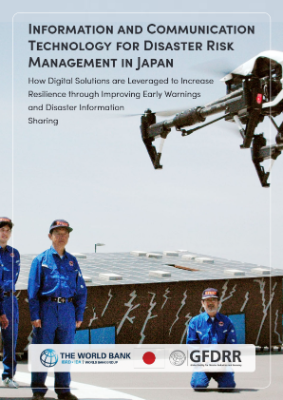How Digital Solutions are Leveraged to Increase Resilience through Improving Early Warnings and Disaster Information Sharing
Breakthroughs in information and communication technology (ICT) increasingly offer new tools to support disaster risk management (DRM). Due to the rapid advancement of computing and communication devices, ICT’s capacity to improve the DRM framework became a critical factor to strengthen resilience. As a nation with high levels of disaster risk and technological development, Japan has developed several forward-looking ICT for DRM. This report highlights the application of ICT for DRM in two specific areas: Early Warning System (EWS) and Disaster Information Management System (DIMS). The analysis of eight Japanese case studies of ICT solutions for DRM across various sectors, hazards, and levels of governance gives insight into their development, selection process and enabling environments, and provides case-specific lessons and recommendations.
Purpose
This report is intended as a reference tool for global DRM practitioners seeking to develop an enabling environment for applying ICT solutions toward resilience. The lessons learned from the Japanese case studies are intended to support practitioners and decision-makers in other countries to envision and explore ways to better leverage ICT to strengthen resilience. While valuable information can be extracted from the analysis, each case is contextualized within its particular social, political and environmental framework: our recommendations should be adapted to local needs and capacities.
Early Warning Systems (EWSs)
EWSs are integrated systems of hazard monitoring, forecasting and prediction, disaster risk assessment, communication and preparedness activities systems and processes that enable individuals, communities, governments, businesses and others to take timely action to reduce disaster risks in advance of hazardous events (United Nations, 2016). In Japan, EWSs were developed primarily for hydrometeorological or geological events. The following EWSs from Japan are discussed in Chapter 3:
- Earthquake Early Warning System (EEWS)
- J-ALERT: Nationwide instantaneous warning system
- Emergency Alert Mail (EAM): a cell broadcast early warning system
These 3 ICTs are part of a larger warning system ecosystem in Japan, in which each plays a well-defined and unique role. EEWS is an alert system based on seismic wave data recorded by seismometer stations. The data are immediately processed to calculate earthquake hypocenter, magnitude and intensity distribution, and warnings are issued seconds before an earthquake strikes, allowing individuals and organizations (e.g., Japan’s high-speed rail system) to take immediate actions. Earthquake early warnings are transmitted via J-ALERT and EAM.
J-ALERT disseminates urgent warnings (for tsunamis, earthquakes, and ballistic missile attacks) via municipal disaster prevention radio receivers, broadcast media, and mobile phones. The mobile phone notifications are delivered via EAM, which sends disaster and evacuation information to mobile phones in warning areas. EEWS and J-ALERT are operated by Japan’s national government; EAM is provided as a free service by mobile phone carriers and was developed with their assistance…..




